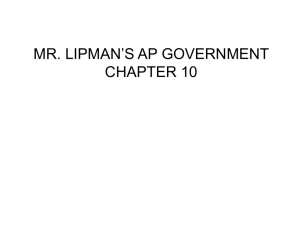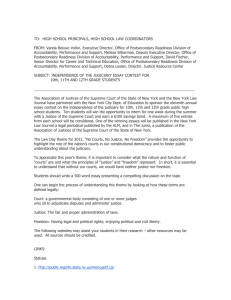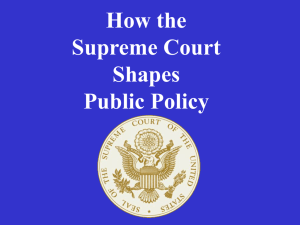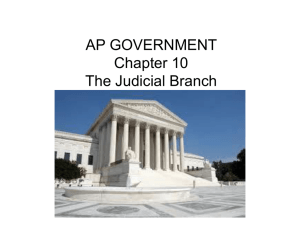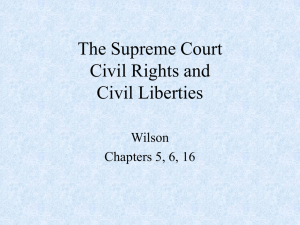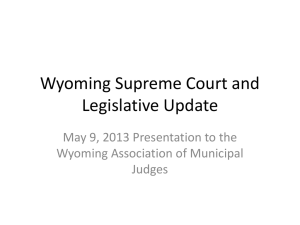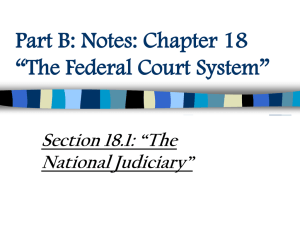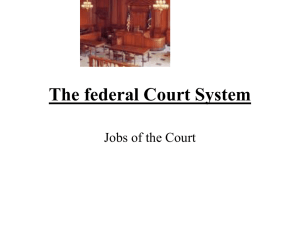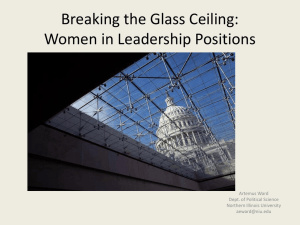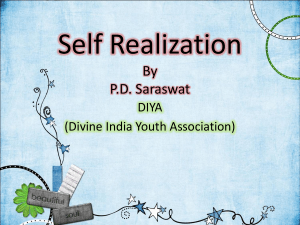American Government and Politics Today
advertisement
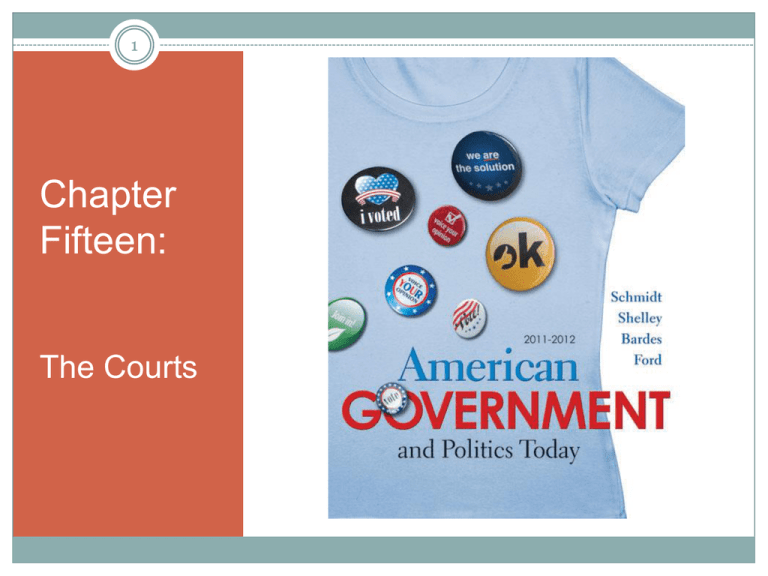
1 Chapter Fifteen: The Courts Learning Objectives 2 Explain such major concepts of the American legal system, such as the common law tradition, precedent, jurisdiction, judicial review, and stare decisis. Identify the sources of American Law. Learning Objectives 3 Outline the federal court system and explain the major function of each court: District Court, U.S. Court of Appeals, and the U.S. Supreme Court. Describe and evaluate the need for secret courts created to combat terrorism. Learning Objectives 4 Identify the parties to lawsuits (plaintiff, defendant) and evaluate the role interest groups may play in filing amicus curiae briefs. Explain the advantage to filing a class-action suit to advancing the agenda of interest groups. Explain the factors that determine which cases reach the U.S. Supreme Court. Learning Objectives 5 Summarize the presidential appointment process for all levels of federal courts including nominating candidates, their common qualifications, the role of senatorial courtesy, and how ideology has played an important role in the politics of appointments. Learning Objectives 6 Identify and explain the different types of opinions that are delivered by justices of the Supreme Court. Unanimous opinion Majority opinion Concurring opinion Dissenting opinion Explain the special role played by the Chief Justice of the U.S. Supreme Court. Learning Objectives 7 Define activist and restraintist philosophies, and strict versus broad construction. Describe the Roberts Court, including its ideology and the types of cases it chooses to hear. Explain the policymaking function of the courts. Describe how the power of the courts is limited and checked. Sources of American Law 8 Constitutions Statutes and Administrative Regulations Case Law The Federal Court System 9 In both the state and federal court systems, before a case can be brought before a court, two requirements must be met: Jurisdiction (court’s authority to hear a case) Standing to sue (justification for bringing suit) The Federal Court System 10 The Federal Court System 11 Types of Federal Courts District Courts U.S. Courts of Appeals U.S. Supreme Court Foreign Intelligence Surveillance Act (FISA) Court Alien “Removal Courts” The Federal Court System 12 The Federal Court System 13 The Supreme Court at Work 14 Which Cases Reach the Supreme Court? Factors that bear on Court’s decision to take a case: Legal question was decided differently by lower courts and needs resolution by the highest court. When a lower court’s decision conflicts with an existing Supreme Court ruling. When the issue could have significance beyond the parties to the dispute. Solicitor general is pressuring the Court to take a case. The Supreme Court at Work 15 Deciding Cases: When four of the Supreme Court justices decide to take a case, a writ of certiorari is issued to call up the records of the case for review. Attorneys Justices in the case present oral arguments. meet privately in conference to decide the case. The Supreme Court at Work 16 Decisions and Opinions: Opinions contain the Court’s ruling on the issue or issues presented, the reasons for its decision, and the rules of law that apply. Can affirm lower court’s decision. Can reverse lower court’s decision. Can remand, or send back, the case to the lower court for retrial. The Supreme Court at Work 17 Types of Opinions Unanimous opinion Concurring opinion Dissenting opinion The Selection of Federal Judges 18 Judicial Appointments Federal District Court Judgeship Nominations Federal Courts of Appeals Appointments Supreme Court Appointments Partisanship and Judicial Appointments The Senate’s Role The Selection of Federal Judges 19 The Selection of Federal Judges 20 Policy Making and the Courts 21 Judicial Review Judicial Activism and Judicial Restraint Strict Versus Broad Construction Policy Making and the Courts 22 What Checks Our Courts? Executive Checks: implementation of decisions Legislative Checks: Constitutional Amendments Rewriting Laws Public Opinion Judicial Traditions and Doctrines Web Links 23 Supreme Court of the United States: decisions are available here within hours of their release: www.supremecourtus.gov. The Oyez Project: A multimedia archive devoted to the Supreme Court of the United States and its work: www.oyez.org/oyez/frontpage. What If…Supreme Court Justices Had Term Limits? 24 The Supreme Court justices are not elected officials, and barring gross misconduct, they also hold their offices for life. Prior to 1970, the average term was 15 years. What If…Supreme Court Justices Had Term Limits? 25 If terms were limited, then There could be reduced rancor surrounding confirmation hearings. The United States would be like other democracies. Vacancies would occur on a regular basis. Retirements would not be politically timed. You Can Make a Difference: Volunteer in the Courts 26 All court systems in the United States are overburdened with too many cases and too few employees to provide needed services. You can: Observe the courts in session to learn about the system. Volunteer with your school’s student legal services office. You Can Make a Difference: Volunteer in the Courts 27 Volunteer for such positions as helping at the Information Desk, providing services to jurors, working in the business office, providing tours and assisting in the Children's Waiting Rooms. Become "volunteer lawyers," helping individuals in completing forms, applying to the right court, and dealing with court processes.


